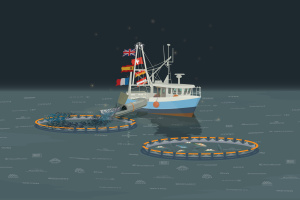Fishing for Catastrophe

Executive summary
Based on findings from on-the-ground investigations carried out in India, Vietnam and The Gambia in mid-2019, this report presents damning evidence that the production of fishmeal and fish oil (FMFO) for use in global aquaculture supply chains is precipitating the collapse of fish stocks, compromising food security, and destroying the social and economic fabric of communities living adjacent to historic fishing grounds at a time when the oceans are being pushed to the brink by the impacts of climate change, pollution and overexploitation. Using information gathered from in-depth supply-chain research, the report, which is the first to map FMFO supply chains from fishery to fork, also establishes links between unsustainable – and often illegal – FMFO sourcing practices in the countries investigated and among major European aquafeed companies and retailers.
FMFO is mainly used as an ingredient in feeds for aquaculture and agriculture. Almost one-fifth of the world’s annual wild-fish catch is taken out of the ocean for this purpose. Roughly one-third of FMFO goes to the agricultural sector (5% to chickens, 23% to pigs), but aquaculture became the dominant user of ‘reduction fisheries’ (which supply fish for FMFO, rather than for direct human consumption)A in the early 2000s. In 2016, 69% of fishmeal and 75% of fish-oil production went to seafood farming. Global demand for FMFO is mainly driven by China’s huge aquaculture sector, but export-oriented sectors, such as salmon farming in Norway and Scotland and prawn farming in Asia, are also significant consumers.
The biggest reduction fishery, typically representing 30–35% of world production of FMFO, is Peruvian anchoveta. However, other regions are also important suppliers of the global market and, as such, require close scrutiny. In Asian countries, where a broader diversity of fish species is used than in South America and northern Europe, locally produced FMFO often supplies domestic seafood farms with direct or indirect links to overseas retail markets. Our investigations found that in two of the region’s key FMFO- and aquaculture-producing countries, India and Vietnam, collapsing fish stocks and the economics of the FMFO industry are pushing fishing vessels to systematically plunder the oceans for species that have not previously been used for FMFO production, as well as juvenile fish, which should be left in their natural environment to reach maturity and ensure a stable fish population.
Increasing demand in major markets – notably China – has also spurred growth in West African FMFO production; according to UN Comtrade figures, in 2016, it produced 7% of the world’s fishmeal. Some countries have experienced a particularly steep rise in production; for example, half of Mauritania’s fish catch is used to produce fishmeal. Shockingly, in The Gambia, where GDP was a mere $1,700 per capita in 2018 and people rely on fish as a staple food, our investigation found that the combined catch of just one of the country’s FMFO plants accounted for approximately 40% of the country’s total reported fish catches in 2016. Gambia’s fish catch is turned into fishmeal at a rate of 5 kilos of fish for 1 kilo of fishmeal and exported abroad, mainly to China.
You might also like...

Atrapados: Cómo los supermercados españoles abordan el empleo de pescado salvaje en su cadena de suministro acuícola
This report looks at how effectively Spanish supermarkets are safeguarding the health of the oceans, through the sustainability of their farmed fish supply chains. Read our Spanish language report:

Krill, Baby, Krill: The corporations profiting from plundering Antarctica
This report investigates the main culprits responsible for the plundering of the cornerstone of the Antarctic food web: krill. Much of the marine life in the Southern Ocean is either a direct predator of ...

Floundering Around: An assessment of where European retailers stand on the sourcing of farmed fish
This report offers a comparative review of 49 leading European supermarket chains’ policies on farmed fish. Based on extensive research it identifies leaders and laggards.